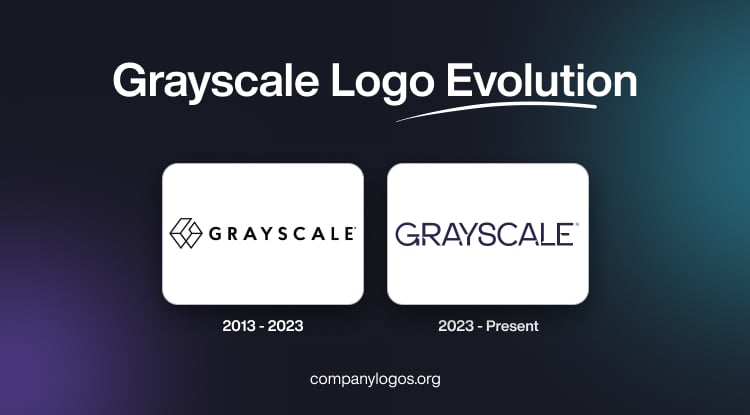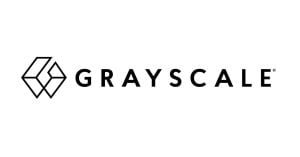
Grayscale Investments is one of the world’s largest and most influential digital asset managers. It specialises in cryptocurrency-based investment products that are designed for traditional investors. Founded in 2013 by Barry Silbert, the company was created to make it easier for individuals and institutions to gain exposure to Bitcoin and other cryptocurrencies without the challenges of direct ownership, custody, or security.
The visual identity of Grayscale has evolved considerably since the company’s founding in 2013. The article delves into the evolution of the Grayscale logo, among other details of the company.
The Genesis of the Grayscale Logo (2013 – 2023)
The original Grayscale logo consisted of a graphical emblem as well as a wordmark in black. The graphical emblem used a geometric mark, that is, a hexagon or diamond-like shape, to project trust, stability, and resilience. It reassured investors about the often-volatile crypto market. Besides, the interlocking hexagon looks similar to digital blocks or chain links, a subtle nod to blockchain technology. The wordmark to the right or below the emblem was a clean and uppercase one written using a sans-serif typeface.


(2023 – Present)
The most significant transformation in Grayscale’s visual identity occurred in 2023, and it coincided with the tenth anniversary of the company. This comprehensive rebrand was developed in partnership with Elephant, a creative agency within the IPG network.
The centrepiece of the 2023 rebrand was the introduction of a distinctive triangular motif representing interconnected Shares. The triangular emblem modified the wordmark, written in a custom sans-serif typeface, wherein some letters received triangular cuts or stylisation.
This new visual element consisted of triangles that fold into and out of one another. The triangles created a dynamic and flexible design system that could adapt across various applications. The triangular emblem represented the connected nature of Grayscale’s investment.

The Elements of the Grayscale Logo
Font
The wordmark of the Grayscale logo uses a custom sans-serif typeface to convey clarity and strength. The letters of the wordmark are geometric with clean edges and balanced proportions. They convey a sense of stability and forward motion.
Colour
The colour palette of the Grayscale logo comprises black, grey, and white. Here, black conveys authority and professionalism, while grey represents balance, neutrality, and trustworthiness. White is used as negative space to ensure crisp visibility.
The History of Grayscale
Grayscale Investments was founded in 2013 by Barry Silbert, who was the entrepreneur behind Digital Currency Group (DCG). He founded the company with the goal of creating regulated investment products that provided exposure to cryptocurrencies without requiring direct ownership or custody. Its first product, the Bitcoin Investment Trust (BIT), which was later renamed the Grayscale Bitcoin Trust (GBTC), was launched the same year and became one of the earliest publicly quoted securities backed by Bitcoin. It gave investors an accessible entry point into the digital asset market.
Building on this success, Grayscale expanded its offerings over the next several years. It introduced single-asset trusts such as the Ethereum Trust (ETHE) in 2017 and later products tied to Litecoin, Bitcoin Cash, and Ethereum Classic. It also introduced diversified funds like the Grayscale Digital Large Cap Fund (GDLC) that tracked a basket of major cryptocurrencies. By 2020, the company had become the first digital asset manager to register with the SEC. And during the 2020–2021 crypto boom, its assets under management soared past $50 billion, thereby establishing Grayscale as the world’s largest crypto asset manager.
As Bitcoin futures ETFs gained traction in the U.S., Grayscale began pushing to convert GBTC into a spot Bitcoin ETF. In 2021, it formally applied to the SEC, but the application was rejected in 2022. However, Grayscale responded with a lawsuit, arguing that the decision was arbitrary since futures-based ETFs had already been approved. In August 2023, a U.S. appeals court ruled in favour of Grayscale. It was a landmark moment that paved the way for regulatory progress.
The breakthrough came in January 2024, when the SEC approved several spot Bitcoin ETFs, including the conversion of GBTC. This marked a historic milestone for the company and the crypto industry at large. In parallel with these regulatory achievements, Grayscale underwent a brand refresh in 2023. It introduced a modernised logo and identity system that reflected its evolution from niche crypto pioneer to mainstream asset manager.
Grayscale continues to expand its lineup with products tied to Ethereum and other emerging digital assets. It maintains its role as a bridge between traditional finance and the crypto economy while shaping the future of regulated crypto investment.
Interesting Facts About Grayscale
- Grayscale was founded in 2013 and became one of the earliest companies to create regulated investment products for digital assets. Its Bitcoin Investment Trust (now GBTC) was among the first publicly traded securities backed by Bitcoin.
- At its peak during the 2021 crypto bull run, Grayscale managed over $50 billion in assets under management (AUM). This made it the world’s largest digital asset manager.
- For years, Grayscale’s products were one of the only ways traditional investors, such as hedge funds, pension funds, and family offices, could gain exposure to Bitcoin and other cryptocurrencies through regular broking accounts.
- Grayscale was a first mover in trying to convert GBTC into a spot Bitcoin ETF in the U.S. Although it was initially rejected by the SEC, the firm pursued a high-profile lawsuit that led to a historic legal victory in 2023.
- In August 2023, a U.S. appeals court ruled in favour of Greyscale, stating that the SEC had been unfair in rejecting its ETF application. This ruling was considered a turning point for crypto regulation in the U.S.
- In January 2024, the SEC finally approved the first batch of spot Bitcoin ETFs, and Grayscale’s GBTC was among them. This cemented the company’s role in bringing mainstream recognition to digital assets.
- Beyond Bitcoin, Grayscale has launched trusts for Ethereum, Litecoin, Bitcoin Cash, Ethereum Classic, Stellar Lumens, Zcash, and more. It also launched diversified funds like the Grayscale Digital Large Cap Fund (GDLC).
- In 2023, Grayscale underwent a major brand refresh. It introduced a bold new logo and visual identity system to reflect its shift from niche crypto pioneer to established institutional asset manager.
- Grayscale is a subsidiary of Digital Currency Group (DCG), which is a leading crypto venture capital firm founded by Barry Silbert. DCG has backed major crypto companies such as Coinbase, Ripple, and Circle.
- Grayscale has acted as a bridge between traditional finance and digital assets. It provided a regulated, familiar structure that helped bring billions of institutional dollars into the crypto ecosystem.
Finally
The evolution of the Grayscale Investments logo represents more than just a visual refresh. It chronicles the journey of the company and the broader cryptocurrency investment industry. Its latest triangle-motif logo design reflects how the company underwent transformation from a pioneering startup to an established leader in digital asset management.